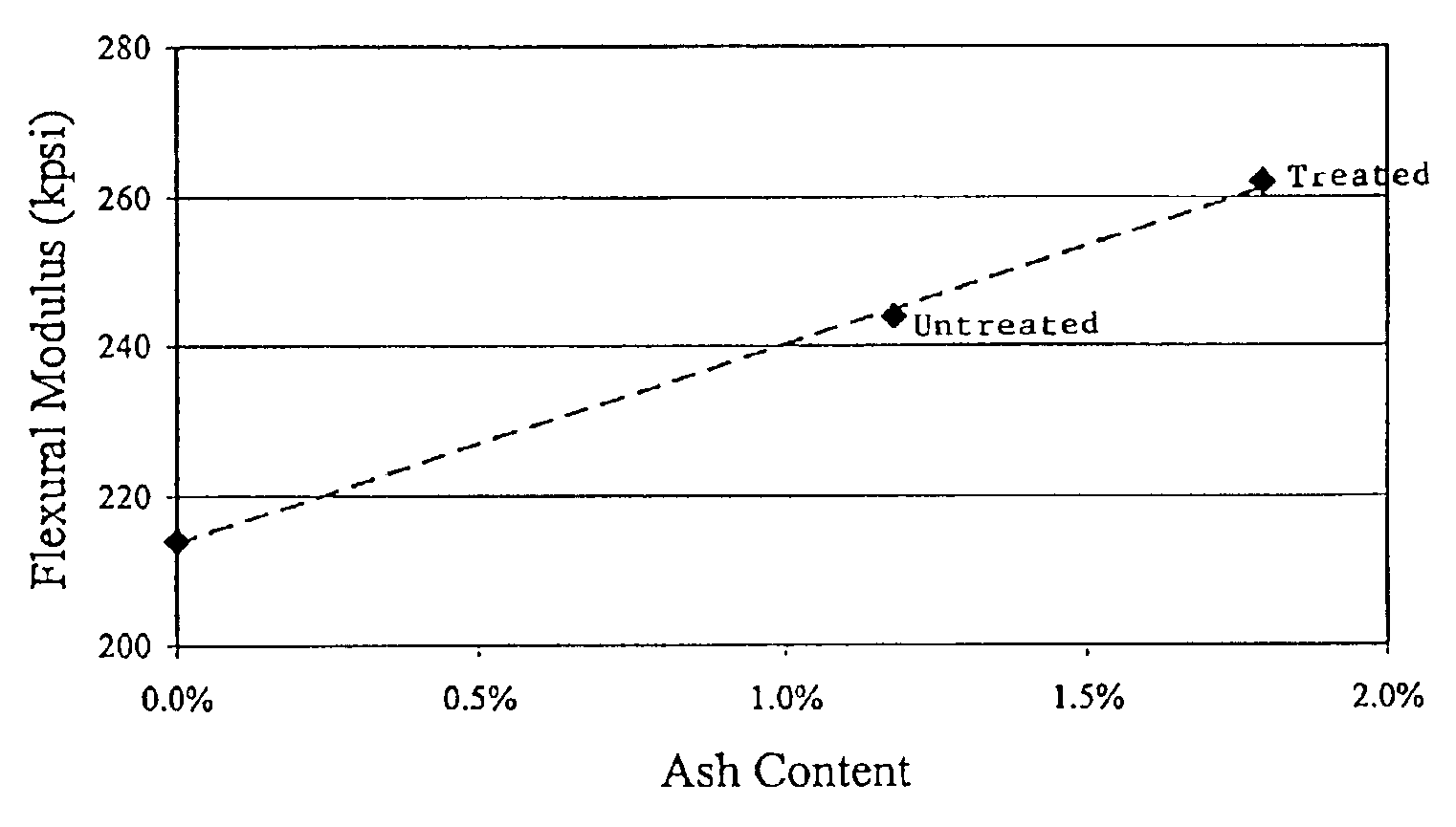Method for making polyolefin nanocomposites
a technology of polyolefin and nanocomposites, which is applied in the field of process for preparing nanocomposites, can solve the problems of significant impact on the cost of finished products, and achieve the effect of increasing modulus
- Summary
- Abstract
- Description
- Claims
- Application Information
AI Technical Summary
Benefits of technology
Problems solved by technology
Method used
Image
Examples
example 1
[0023]This example shows the effect on the physical properties of the nanocomposite product when an amide intercalating agent is used rather than a maleic anhydride-grafted polypropylene compatibilizing agent.
[0024]The compositions shown in Table 1 were compounded on a 40 mm Coperion co-rotating twin screw extruder. The extrusion conditions were: barrel temperature=190° C., RPM=400. All samples were injection molded into ASTM tensile bars on a 5 oz Battenfeld molding machine at a barrel temperature of 390° F., a mold temperature of 140° F., and an injection speed of 1 in / sec. The physical properties of each sample are given in Table 1.
[0025]In Table 1, the polypropylene (PP) was a homopolymer having a MFR of 4 dg / 10 min, commercially available from Basell USA Inc. The MA-g-PP was Epolene E43 modified polypropylene wax having an acid number of 45, a number average molecular weight Mn of 3900, and a weight average molecular weight Mw of 9100, commercially available from Eastman Chemic...
example 2
[0028]This example shows the effect on the physical properties of the nanocomposite product when glycerol monostearate (GMS) is used as the intercalating agent, with or without MA-g-PP.
[0029]The samples were compounded and then injection molded into ASTM tensile bars as described in Example 1. The physical properties of each sample are given in Table 2.
[0030]The PP, MA-g-PP, organoclay, and stabilizer were the same as in Example 1.
TABLE 2Sample NoControl 1Control 2123456PP (%)10091.8095.8094.8093.8092.8087.8087.80MA-g-PP (%)5.005.007.00GMS (%)1.002.003.004.004.002.00Organo-clay (%)3.003.003.003.003.003.003.00Stabilizer (%)0.200.200.200.200.200.200.20MFR @0 2.16 kg4.04.44.0(dg / 10 mm)TensileStrength @ yield5.255.265.255.265.125.004.945.16(kpsi)Elong. @ yield11.39.69.18.98.98.79.69.1(%)Elong. @ break409210710312610412064(%)FlexuralModulus (kpsi)214230247240241238216228Strength (kpsi)6.927.097.237.246.946.806.536.96Modulus increase—71512131117(%)Notched Izod (ft0.50.60.70.81.01.00.70.5l...
example 3
[0032]This example provides a comparison between the physical properties of nanocomposites made with equal amounts of three amide intercalating agents, and those of nanocomposites made with MA-g-PP and no intercalating agent.
[0033]The samples were compounded and molded into ASTM tensile bars as described in Example 1. The physical properties of each sample are shown in Table 3.
[0034]The PP, MA-g-PP, organoclay, and stabilizer are the same as in Example 1. Kemamide B saturated fatty amide is derived from a mixture of arachidic and behenic acids. Kemamide S-180 secondary amide is a substituted fatty amide derived from stearic acid and stearyl amine. Both are commercially available from Crompton Corporation.
TABLE 3ControlControlSample No.12123PP (%)10091.8094.8094.8094.80MA-g-PP (%)5.00Kemamide B (%)2.00Kemamide S180 (%)2.00EBS (%)2.00Organoclay (%)3.003.003.003.00Stabilizer (%)0.200.200.200.20MFR @ 2.16 kg4.05.24.64.84.6(dg / 10 mm)TensileStrength @ yield5.255.145.014.955.06(kpsi)Elong....
PUM
| Property | Measurement | Unit |
|---|---|---|
| thickness | aaaaa | aaaaa |
| temperature | aaaaa | aaaaa |
| mold temperature | aaaaa | aaaaa |
Abstract
Description
Claims
Application Information
 Login to View More
Login to View More - R&D
- Intellectual Property
- Life Sciences
- Materials
- Tech Scout
- Unparalleled Data Quality
- Higher Quality Content
- 60% Fewer Hallucinations
Browse by: Latest US Patents, China's latest patents, Technical Efficacy Thesaurus, Application Domain, Technology Topic, Popular Technical Reports.
© 2025 PatSnap. All rights reserved.Legal|Privacy policy|Modern Slavery Act Transparency Statement|Sitemap|About US| Contact US: help@patsnap.com


